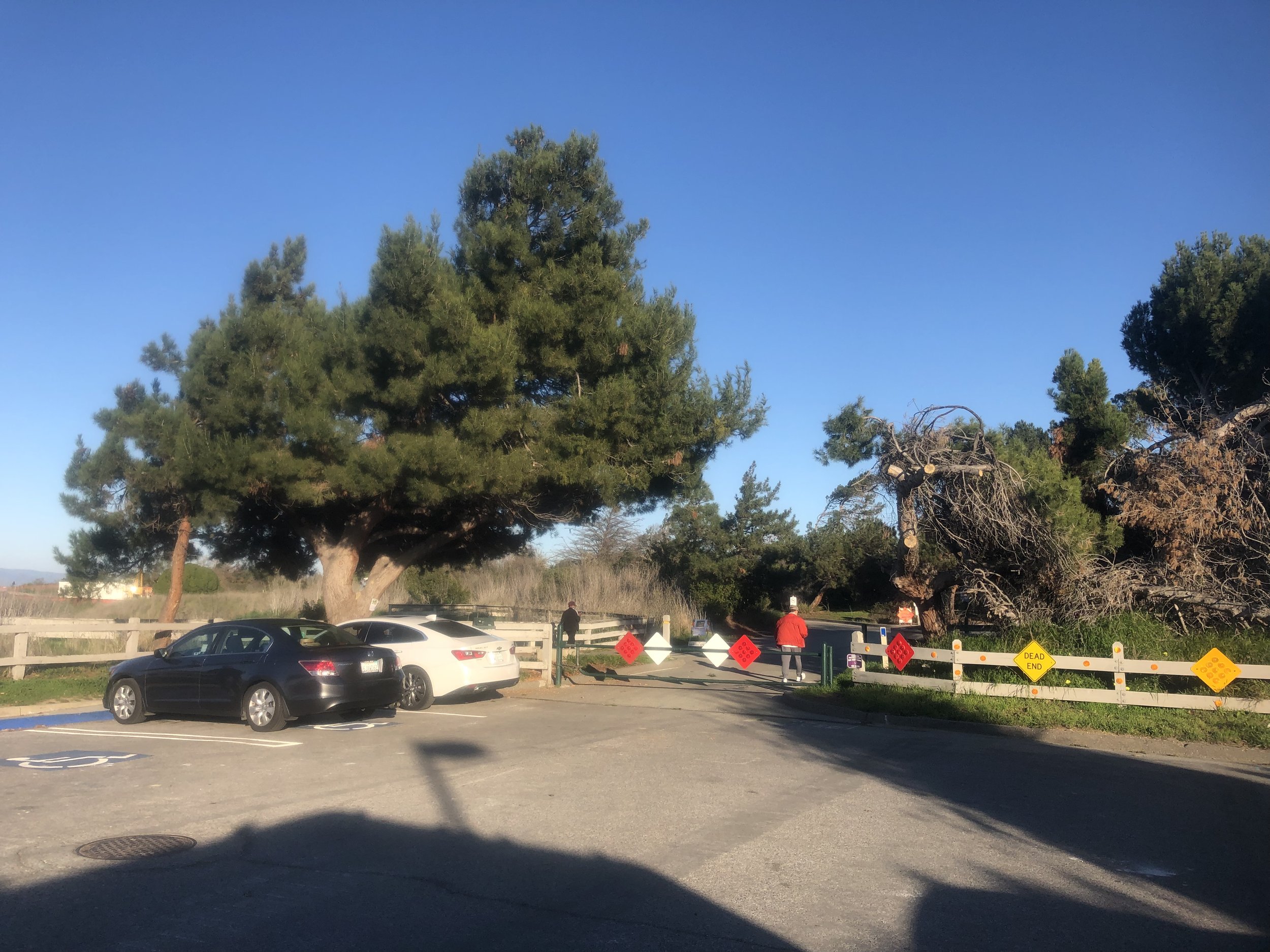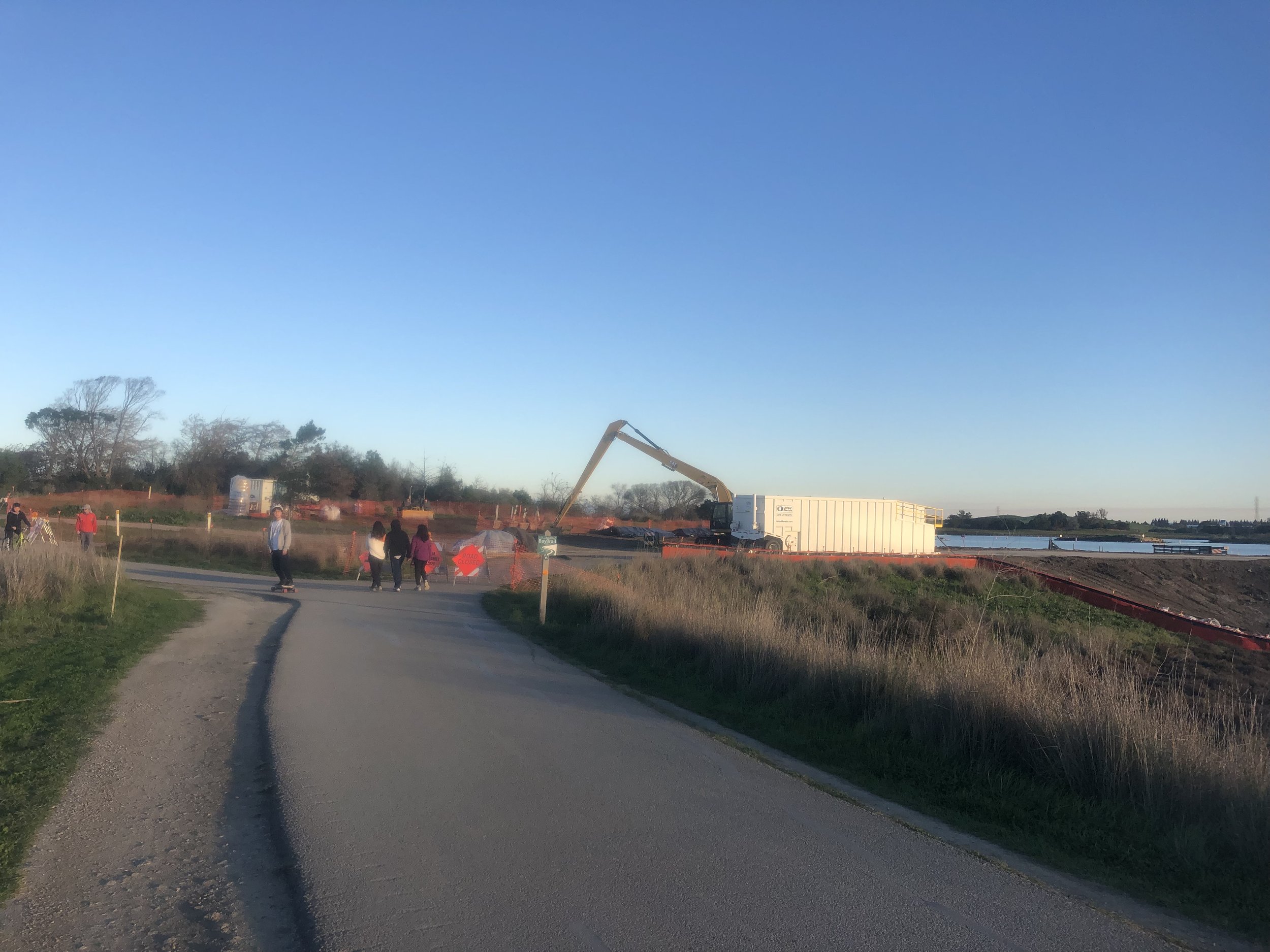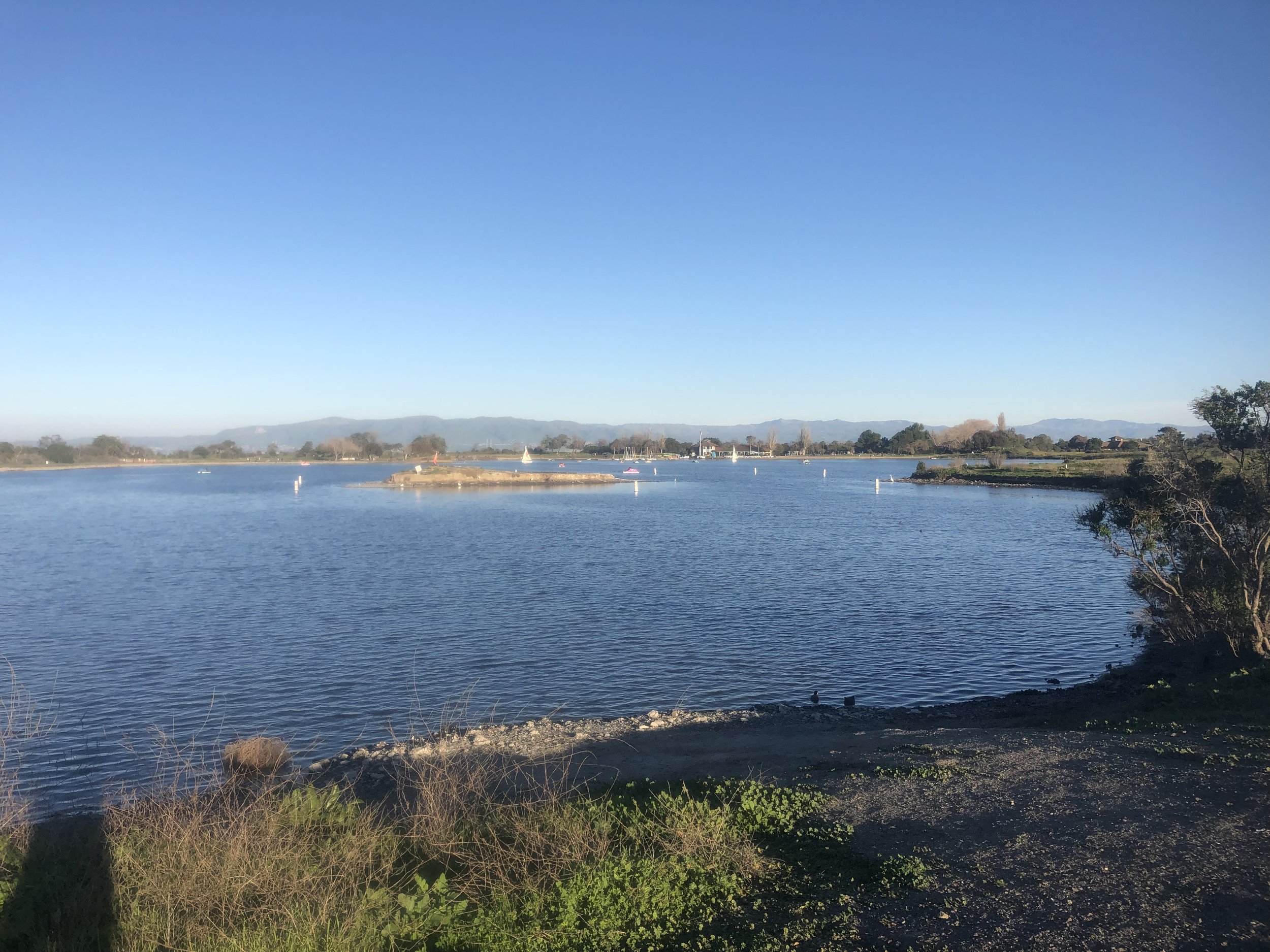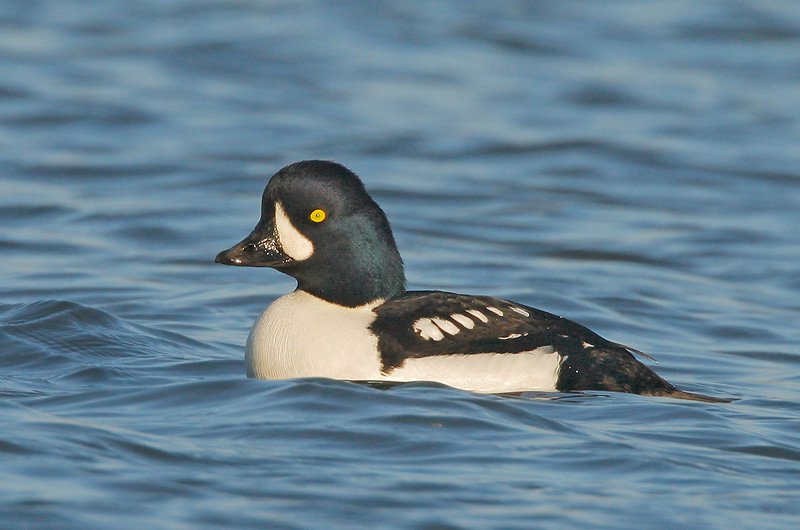Shoreline Lake (Winter/Spring):
From Scoters and Goldeneye to Skimmers and Terns
By Adam Burnett
Along the bayfront in Mountain View, Shoreline Lake offers close-range views of waterbirds like Surf Scoters and Eared Grebes, occasional less-common species such as Horned Grebe and Barrow’s Goldeneye, and the ever-present possibility of finding an ocean-going rarity. Ducks are most numerous in winter, while in early spring, the spectacle of breeding Black Skimmers and Forster’s Terns returns to the lake.
Trip Covers: November - March
Key Birds: Surf Scoter, Common Goldeneye, Barrow’s Goldeneye, Horned Grebe, Eared Grebe, Forster’s Tern, Black Skimmer
How to Bird
Shoreline Lake is an artificially constructed saltwater lake along the San Francisco Bay shore in Mountain View, part of the “Shoreline at Mountain View” park complex. In addition to walking, boating, and picnicking, Shoreline Lake and its surroundings provide excellent birding throughout the year. Waterfowl and gulls are present in greatest variety during the winter, often providing close-range views as they visit the lake from the salt ponds to the north and Charleston Slough to the west. Popular with photographers, Great and Snowy Egrets forage around the edges of the lake throughout the year, often very tolerant of people walking on the trails nearby. In summer, bird activity at the lake is dominated by Black Skimmers and Forster’s Terns, which inhabit a breeding colony on the lake’s island. As winter gives way to spring, these summer residents begin to return, while many of the winter visitors linger, making March one of the best times of year to visit this spot.
This trip guides you on a 2.5-mile walking loop clockwise around Shoreline Lake and through adjacent parts of Shoreline at Mountain View, starting and ending at the parking area on Terminal Boulevard. As of this writing in February 2022, a segment of trail along the west side of Shoreline Lake is closed for construction, so this trip also describes the detours you need to take. Without these detours, the loop would be approximately 1.9 miles.
Looking east from parking area at Terminal Boulevard.
From the Bay Trail trailhead at the intersection of Terminal Boulevard and San Antonio Road (“Parking” point on interactive map), walk northward. To your right is the Mountain View Forebay, also called the “Coast Casey Forebay”, itself a birding destination worth checking for a wide variety of birds including ducks, shorebirds, and gulls. For now, continue northward until you reach the Bay Trail junction at the pumping station at the northwest corner of the forebay (point 1 on interactive map). At this intersection, turn right and follow the Bay Trail eastward along the north edge of the forebay—the forebay will be on your right, and on your left will be Charleston Slough and Salt Pond A1. Continue until you reach the trail junction at the western tip of Shoreline Lake (point 2), with the lake visible ahead of you.
Looking east from Bay Trail to Shoreline Lake.
Normally, you would continue straight ahead, onto a pedestrian-only trail leading along the north shore of the lake. However, there is currently a construction fence blocking this trail, so you will have to detour around the closed area. Follow the detour to the left, taking the Bay Trail along the south edge of Salt Pond A1. After about 0.3 miles, you will encounter a paved trail coming in from the right (point 3). Take a sharp right onto this paved path and follow it back to the lake, where it rejoins the trail along the north shore of the lake (point 4).
Looking back along closed section of trail along north edge of lake.
Congratulations—you have successfully navigated the construction and are now ready to look for birds at Shoreline Lake! The north shore of the lake, particularly along the northwest side, is often best for a variety of waterfowl. Surf Scoters hang out here most often, and are often joined by Greater and Lesser Scaup, Canvasbacks, Buffleheads, and American Coots. Bird activity on the lake tends to be best in the early mornings, when there are fewer boats around. Pied-billed Grebes are present throughout the year, joined in winter by Eared Grebes and the occasional Horned Grebe. An adult Glaucous-winged Gull often rests on the dock at the lake’s west end. Ring-billed Gulls hang around the lake for much of the year, and California Gulls come and go from neighboring Charleston Slough. Attracted by all these birds at close range, photographers gather here in the evenings, particularly at the lake’s northwest corner.
As you continue walking along the north side of the lake, scan the lawn to your left for grazing Canada Geese and American Coots. The goose flocks here regularly attract less-common species such as Cackling Goose and Greater White-fronted Goose. These geese travel among various grassy areas at Shoreline, including the golf course and the kite flying area to the east, but this lawn seems to be a regular stop on their itinerary. Killdeer, American Pipits, and Western Meadowlarks also visit this lawn, especially before it fills up with afternoon picnickers, while the regular Western Bluebirds here are more tolerant of human activity.
Looking east from Bay Trail to Shoreline Lake.
The northeast corner of the lake seems to be one of the best areas to find Horned Grebe here. Compared with Eared Grebe in winter plumage, look for a slightly larger and noticeably thicker-necked bird with a sharper contrast between black and white coloration on the head and neck. The bill of the Horned Grebe is thicker, and in the right lighting a white tip is visible, absent in Eared Grebe. Study a field guide for more help with this tricky identification problem. Fortunately, when Horned Grebes are here at Shoreline Lake, they are often close to shore and side-by-side with Eared, providing a good comparison.
Horned Grebe by Brooke Miller.
Eared Grebe by Brooke Miller.
Continue walking along the north shore of the lake. As you reach the boat rental area and restaurant at the northeast corner, walk southward through the parking lot and scan from the grassy beach area on the lake’s east side. Ring-billed Gulls, American Coots, and Canada Geese often loaf here, perhaps hoping for dropped picnic scraps.
Grassy beach area at east end of lake.
Shoreline Lake is one of the better places in Santa Clara County to look for various oceanic birds that rarely venture this far south in San Francisco Bay. Recent examples have included Brandt’s Cormorant (2021), Common Loon (2021), Brant (2020-2021), and Wandering Tattler (2020), any of which might appear again during the winter season. Though seen in summer rather than winter, a Common Tern and a Black Tern each spent time at Shoreline Lake in 2021, and an amazing flyover record of a Long-tailed Jaeger in August 2020 also deserves mention. Looking further back in the annals of eBird and South Bay Birds, other oceanic rarities here have included White-winged Scoter, Black Scoter, Long-tailed Duck, Red-necked Grebe, Heermann’s Gull, Red-throated Loon, Pacific Loon, Brown Booby, and Pelagic Cormorant. Clearly this spot has a long history and lots of potential! As you scan the birds on the lake, always keep in mind the possibility of something unexpected.
When you are satisfied with the lake for the time being, continue southeast along the south edge of the parking lot, past the Rengstorff House (point 5). The cottonwoods and other deciduous trees in the garden adjacent to the house may host a variety of songbirds, including occasional rare migrants, such as a Chestnut-sided Warbler in October 2020. Also look for White-crowned and Golden-crowned Sparrows in the bushes nearby, and check among them for White-throated Sparrow, found here a few times in recent years. For that matter, the brushy areas to the north of the lake also offer nice land-based birding—they hosted two Vesper Sparrows in 2020. Rarities of all kinds may show up here!
Continuing past the Rengstorff House, you should find yourself on a paved pedestrian path which soon crosses a pedestrian bridge over Permanente Creek (point 6), just south of North Shoreline Boulevard. Immediately upon crossing the bridge, a trail comes in from the right. Take it and follow it southward, with Permanente Creek on your right. You will pass a parking lot, the golf course buildings, and one of the golf course ponds, which is worth scanning for geese, ducks, and Great-tailed Grackle. Continuing southward on this trail, you reach a junction at another bridge over Permanente Creek (point 7). At this junction, make a right turn onto the paved Shoreline maintenance road, which crosses the bridge. Follow the road westward and northward, back toward Shoreline Lake. After 0.7 miles, this road rejoins the lake at a vantage point (point 8) which provides the best views of the lake’s southwestern portion, including the island.
View of cove and island at southwest part of lake.
This cove is one of the best places in the lake to see Common Goldeneye, with the occasional Barrow’s Goldeneye among them. A hallmark of the goldeneye, the adult male’s white facial spot is circular in Common Goldeneye, while it is crescent-shaped in Barrow’s. Another important feature for identifying male goldeneye is the extent of the black on the back. Males of both species have a black back, white sides, and alternating strips of black and white between the two. The Barrow’s Goldeneye has a more extensively black back, and along the border with the white sides, its thin strips of white are surrounded by black. The Common Goldeneye is somewhat opposite, with less black on the back, more white coloration on the sides, and alternating strips of white and black that are mostly white, giving the appearance of thin strips of black surrounded by white. Finally, the male Barrow’s has a “spur” of black coloration extending down through the white coloration on the side of his chest, from his black back down toward the waterline.
Male Barrow’s Goldeneye by Tom Grey
Male Common Goldeneye by Tom Grey
Identification of females and immature males is more difficult, as they lack these distinguishing markings. Instead, the most important field mark for females is head shape: Common has a high, peaked crown, while Barrow’s has a flat-looking crown and a steep forehead, giving its head a pushed-forward appearance. Males also exhibit these differences in head shape. Compared to female Common, the female Barrow’s also tends to have more yellow coloration on the bill, but this field mark is not diagnostic. As with Horned and Eared Grebes, close consultation of a field guide is advised, along with lots of practice.
Female Barrow’s Goldeneye by Tom Grey
Female Common Goldeneye by Tom Grey
Common and Barrow’s Goldeneye hybridize, and intermediate-looking individuals which are likely hybrids are also seen here regularly. If you think you see a male Barrow’s, be sure it has all the correct field marks described above—if any are missing or appear intermediate, then it may be a hybrid instead. Complicating matters, the Cornell Lab of Ornithology’s All About Birds page for Barrow’s Goldeneye cites a study of 15 intermediate-looking individuals which found that only two had hybrid DNA. (A similar finding cited on the Cornell Lab’s Birds of the World page for this species refers only to intermediate-looking females.) Despite this caveat, birders at Shoreline and elsewhere generally call intermediate-looking males hybrids, which seems overall like a reasonable course of action.
Forget ID minutiae—in spring and summer, the island bustles with the activity of breeding Black Skimmers and Forster’s Terns. Black Skimmers were first confirmed nesting on this island in 2013, and this breeding colony is now the largest in the Bay Area. Some skimmers spend the winter in the Bay Area, and there are occasional winter sightings along Santa Clara County bayfront, but the skimmers at Shoreline seem to arrive in earnest in late March, staying through mid-September. If you do not see them at the lake, also check Coast Casey Forebay and the flats of Charleston Slough. Like the skimmers, the more common Forster’s Tern is also primarily a summer resident at Shoreline Lake, though a few visit throughout the winter.
Black Skimmer by Carter Gasiorowski
Besides the skimmers and terns, five other bird species have been found nesting on the island: Canada Goose, Mallard, Black-necked Stilt, American Avocet, and Killdeer. Boaters on the lake must keep a minimum distance from the island, marked by buoys, to avoid disturbing the nesting birds. Obviously, birders also must avoid disturbing them—do not trespass into the fenced-off area along the southeast shore of the lake.
Before leaving your vantage point by the edge of the lake, look for shorebirds such as Greater Yellowlegs and Willet, and scan the shaded shoreline to the west for Green Heron. Also look and listen in the scrub on the south of the maintenance road, where California Thrasher and Spotted Towhee are occasionally found, along with numerous Northern Mockingbirds. When you are satisfied here, continue northward and westward on the maintenance road. After another 0.1 mile, the road reaches the west end of Terminal Boulevard, completing your loop.
Ready for More? The same trailhead at Terminal Boulevard also provides access to the Mountain View “Coast Casey” Forebay and Charleston Slough, and to the Bay Trail running northward toward Palo Alto and southward toward Sunnyvale. North of Shoreline Lake are Salt Pond A1 and Salt Pond A2W, and east of Shoreline Lake are the kite flying area and adjacent grassy parking area (Lot E). All are excellent birding spots!
Interactive Map
Directions: From US-101 in Mountain View, take San Antonio Road north to Terminal Boulevard. Park along Terminal Boulevard. Latitude/Longitude: 37.4335, -122.0986
Parking: Paved parking lot with ADA-compliant parking spaces.
Fees: None
Public Transportation: The Mountain View shuttle service MVGo stops at the intersection of Casey Avenue and Marine Way, 300 yards from the Terminal Boulevard trailhead. MVGo also connects with VTA bus routes and Caltrain. VTA bus route 40 stops at Shoreline Boulevard and Amphitheatre Parkway, a 1-mile walk from the Terminal Boulevard trailhead.
Park and/or Trail Hours: Opens 6 AM, closes 30 minutes after sunset.
Facilities: Bathrooms (not wheelchair-accessible) and drinking fountain at Terminal Boulevard trailhead. Several benches along north shore of Shoreline Lake.
Trip Mileage: 2.5 miles
Trail Conditions: Mostly paved with some sections of hard-packed sand. Almost completely flat, with only a couple gentle inclines, primarily at bridge crossings. Full sun exposure. Often crowded near Shoreline Lake, especially in the afternoon.
Accessibility: Normally, it is possible to get great views of birds at the west side of Shoreline Lake by traveling only a short distance from the Terminal Boulevard parking area, but this section of trail is currently closed for construction, necessitating a longer trip to get views of the lake.
Bikes: This is a great trip to do by bike!
Dogs: Dogs are not allowed.
More Information:
eBird hotspot: Shoreline Park--Shoreline Lake area
All About Birds page for Barrow’s Goldeneye
More Resources
For more trips like this one, visit Self-Guided Field Trips.
Visit the SCVAS Birding Resources page for more information on where to bird, our birding community, bird identification resources and more.
Read “What to Look for Now” by SCVAS Executive Director Matthew Dodder.
Banner Photo Credit: Surf Scoter by Brooke Miller
Last Updated: 3/4/2022
Enjoyed this Trip?
Support the work of Santa Clara Valley Audubon Society and become a member. To contact the trip writer with comments, questions or location updates, please email fieldtrips@scvas.org. You can also post in the comment section below. (If you’d like to post anonymously, type your comment, select “Post Comment”, then simply provide a name, like “Guest”, and select “Comment as Guest”.)














